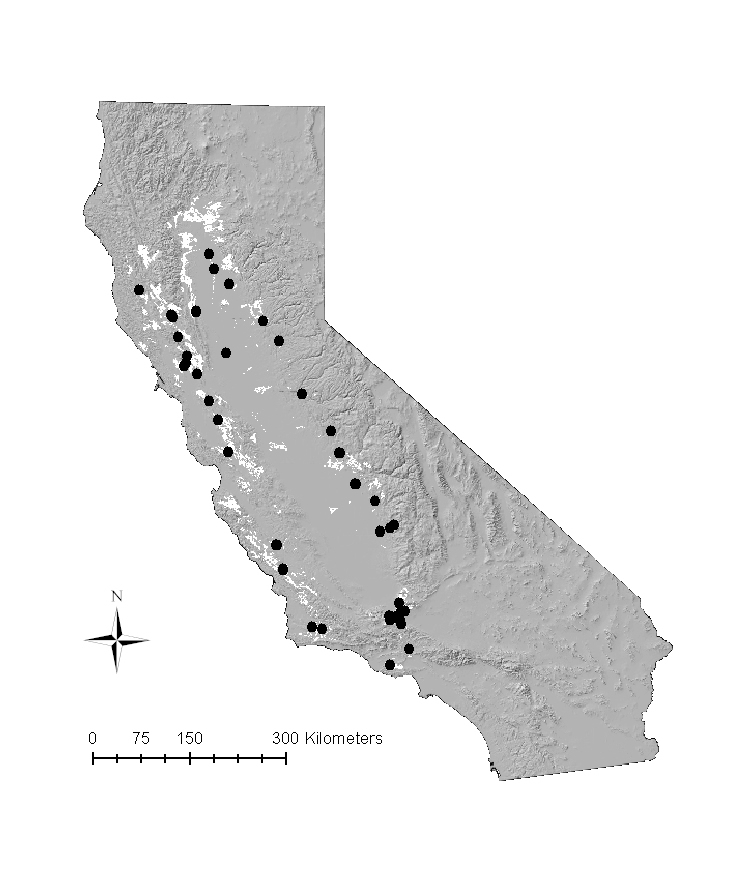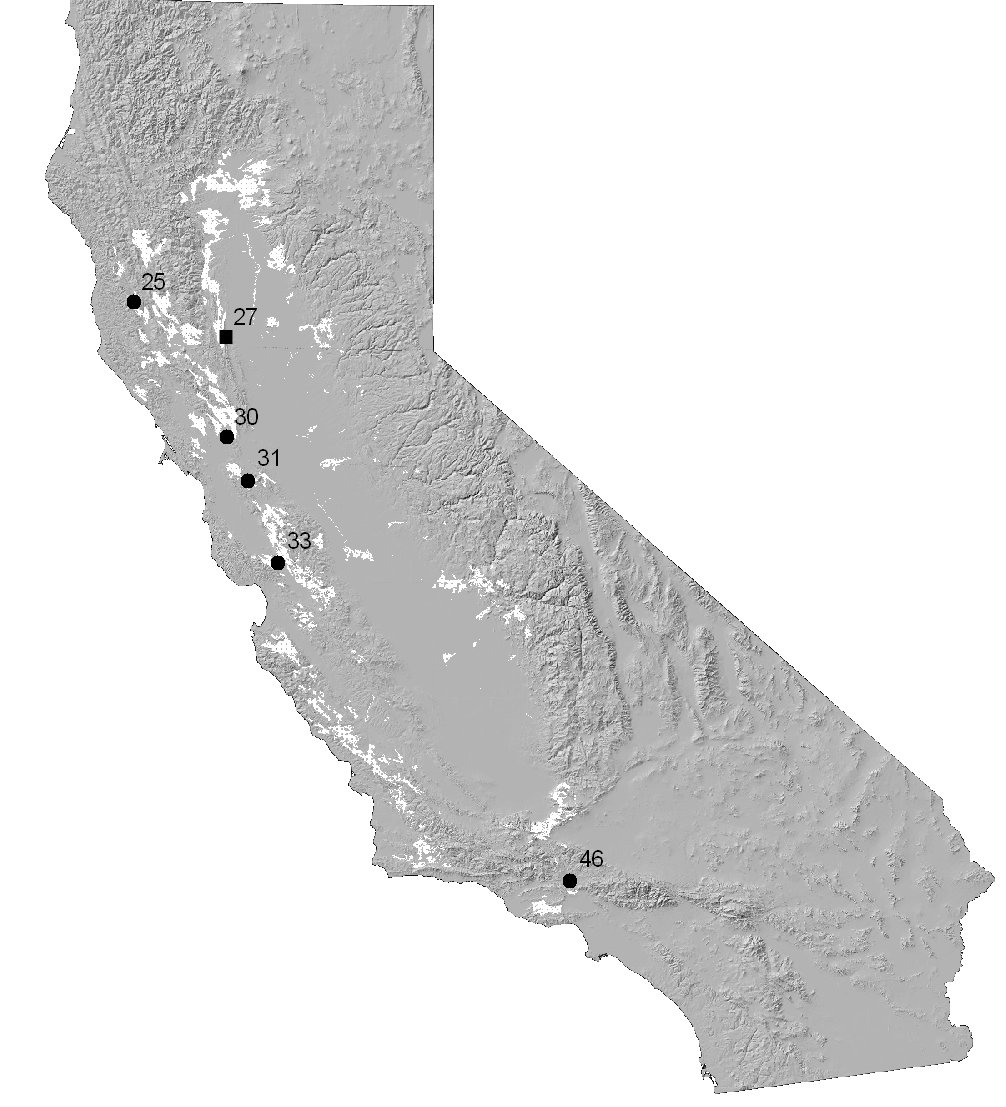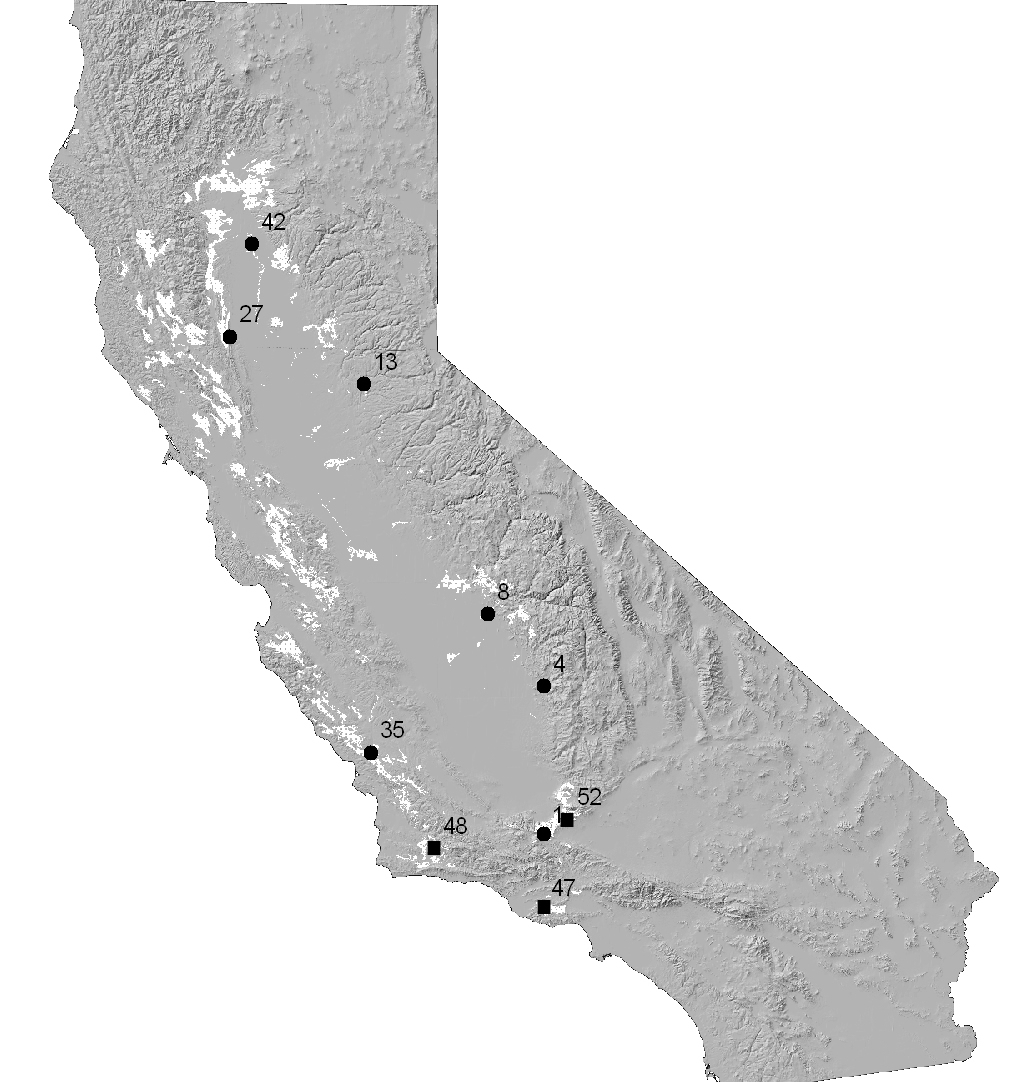Env 121: Conservation of Biodiversity
Topic: Public lands and reserve networks
Professor Sork: 29 May 2007
Guest speaker: Rick Rayburn, California State Parks
Conservation in the news:
Outline of lecture
Presented by Rick Rayburn, Chief of Natural Resources, California State Parks
I. Design of Nature Preserves
A. Historical concepts for reserve design
- SLOSS debate=single large or several small
- oversimplies choices
- depends on how much land you are trying to optimize (e.g. 10,000 acres v 100,000 acres)
- advantages of large reserves:
- Contiguous areas - preserve intact communities of interdependent species.
- Contiguous areas - maintain viable populations of species that require large areas (e.g. large vertebrates).
- advantages of small reserves
- Can sometimes preserve a broader range of species
- Island biogeogeography
- introduced in previous lectures
- emphasizes species richness, not species composition
- has led to the emphasize on size of reserve
B. Considerations of reserve design
- Disturbance regime
- Defn: any discrete event that disrupts ecosystem, community, or
population structure
- equilibrium versus nonequilibrium
- small reserves are vulnerable to disturbances
- Goals of reserve (first three were proposed by
Michael Soulé and Dan Simberloff, 1986)
- Preservation of large and functioning ecosystems (e.g. watersheds)
- Preserve biodiversity (e.g. Biodiversity hotspots, first proposed by Norman Myers)
- Protection of particular species or groups of species (e.g. California condors)
- Protection of ecological or evolutionary process
- (e.g California evolutionary hotspot project)
- Concerns in reserve development
- Biological considerations
- Anthropological or cultural effects
- Political and economic constraints
- Threats and opportunities
B. Six critical issues for reserve design
- Reserve size
- species area curve
- habitat quality?
- How do we determine the appropriate size?
- Extinction-size relationships (recall island biogeography?)
- Population/single species approach
- Home range requirements
- Migration requirements
- MVP
- Ne and maintenance of genetic diversity
- Edge effects
- Disturbance regime
- Heterogeneity and dynamics
- Heterogeneous areas have higher diversity
- Patch dynamics
- disturbance patterns
- patch longevity
- alpha (within patch) and beta (between patch) diversity
- presence in a patch is a function of colonization and extinction
- metapopulation
- Landscape context
- What is the surrounding non-reserve matrix?
- industrial, residential, agricultural
- edge
- Administrative boundary is based on political not ecological considerations
- false edge = more protection within than without
- biotic vs. legal boundaries
- Area-perimeter ratio
- Smaller ratio
- more edge effect, fewer interior, undisturbed habitats
- more management, more cost
- Buffers
- influence land-use plans around reserve
- Human intervention
- direct & indirect
- legal & illegal
- Connecting fragmented habitats
- Corridors
- periodic movement
- migration, seasonal movements
- immigration & emigration
- metapopulation context
- Wildlife corridors
- Fencerow scale
- edge, metapopulation
- Landscape mosaic scale
- daily, seasonal movements
- Regional scale
- MUMS= multiple use modules:
- central, well protected area surrounded by buffer zones.
- management to preserve core area
- What does a corridor look like?
- Line corridor
- entirely edge
- hedgerow, utility strip
- Strip corridor
- broader with interior habitat and patch dynamics
- Natural and modified landscape elements
- defn: relatively homogeneous ecological units
- modified landscape elements: roads, fields, industrial zones
- Exclusion of modified landscape elements is not possible
- Use of landscape elements around natural areas changes
- Buffer zones
- zoning
- model
- reserve core
- buffer zone (compatible with core goals)
- transition zone (can link several reserve systems)
II. Selecting Sites for Reserve Networks
- Background
- Where should reserves be located?
- What are the criteria?
- How do we incorporate socio-economic issues (e.g. costs, feasibility, degree of threat).
- Minimum area problem
- Usually species based
- Goal: minimize number of sites, total area, costs
- Does not take into account persistence of species
- Maximal coverage problem
- Maximize the representation of a natural feature (e.g. species, but could be other issues).
- Goal: best coverage for a limited number of sites, costs, or area
- Example: genetic diversity of valley oak
- Maximum coverage based on chloroplast versus nuclear genetic markers (Sork et al 2006.)



- Reserve design networks may take into account multiple kinds of criteria.
- Sierra Nevada case study (Davis et al 2006)
"Are we protecting the right places and are we getting our money's worth?"
III. Case study: California State Parks as a strategy for conservation
Presented by Rick Rayburn, Chief of Natural Resources, California State Parks
Selected references on reserve design
Cabeza, M. and A. Moilanen (2001). Design of reserve networks and the persistence of biodiversity. Trends in Ecology and Evolution, 16: 242-248.
Chetkiewicz, C. L. B., C. C. S. Clair, and M. S. Boyce. (2006). Corridors for conservation: Integrating pattern and process. Annual Review of Ecology, Evolution, and Systematics 37: 317-342.
Davis, F. W., C. Costello, and D. M. Stoms. (2006). Efficient conservation in a utility-maximization framework. Ecology and Society 11:33. http://www.ecologyandsociety.org/vol11/iss1/art33/
R. H. MacArthur and E. O. Wilson. (1967). The Theory of Island Biogeography. Princeton University Press, Princeton, NJ, 1967.
R. L. Pressey, H. P. Possingham, and J. R. Day. (1997). Effectiveness of alternative heuristic algorithms for identifying minimum requirements for conservation reserves. Biological Conservation, 80: 207-219.
Margules, C., and R. Pressey. 2000. Systematic conservation planning. Nature (London) 405: 243-253.
Sork, V.L. , F.W. Davis, D. Grivet. 2007. Incorporating genetic information into conservation planning for California valley oak. In press in : {roceedings of the Sixth Symposium on Oak Woodlands: California's Oaks: Today's Challenges, Tomorrow's Opportunities. 2006 October 9-12; Santa Rosa, CA. Gen. Tech. Rep. PSW-GTR-XXX. Albany, CA: Pacific Southwest Research Station, Forest Service,
U.S. Department of Agriculture; XXX.
M. E. Soulé and D. S. Simberloff. (1986). What do genetics and ecology tell us about the design of nature reserves? Biological Conservation, 35(1): 19-40
Soulé, M. E. (ED.). (1996). Conservation Biology: The Science of Scarcity and Diversity. Sinauer Associates, Inc.: Sunderland, Mass., USA


